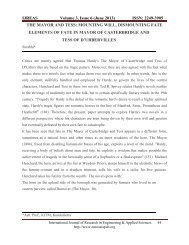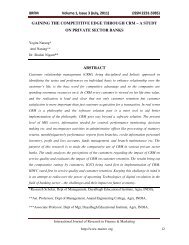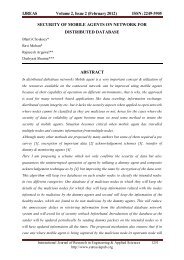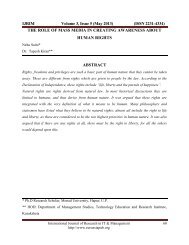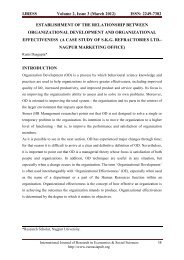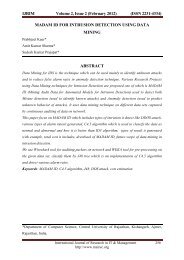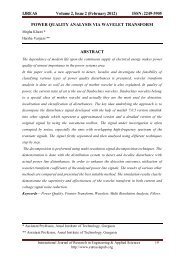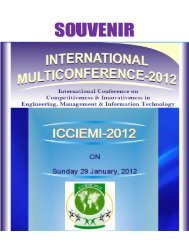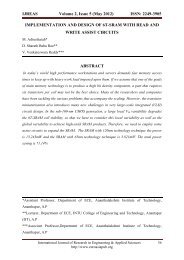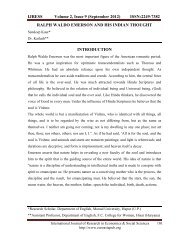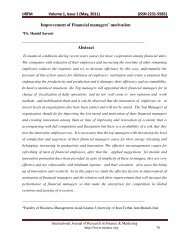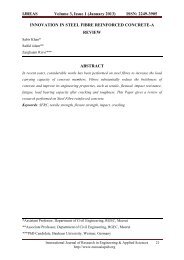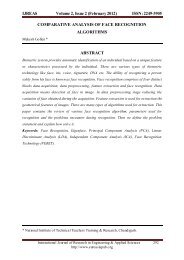impact of corruption and poverty on economic ... - Euroasiapub.org
impact of corruption and poverty on economic ... - Euroasiapub.org
impact of corruption and poverty on economic ... - Euroasiapub.org
You also want an ePaper? Increase the reach of your titles
YUMPU automatically turns print PDFs into web optimized ePapers that Google loves.
IJRESS Volume 2, Issue 12 (December 2012) ISSN: 2249-7382Envir<strong>on</strong>mental Costs: Envir<strong>on</strong>mental degradati<strong>on</strong> is an indirect but serious c<strong>on</strong>sequence <str<strong>on</strong>g>of</str<strong>on</strong>g>corrupt systems. Envir<strong>on</strong>mentally devastating projects are given preference in funding,because they are easy targets for siph<strong>on</strong>ing <str<strong>on</strong>g>of</str<strong>on</strong>g>f public m<strong>on</strong>ey into private pockets (CentralVigilance Commissi<strong>on</strong>, 2010). Corrupti<strong>on</strong> undermines the effectiveness <str<strong>on</strong>g>of</str<strong>on</strong>g> envir<strong>on</strong>mentalpolicies because less effective envir<strong>on</strong>ment regulati<strong>on</strong>s could be easily circumvented throughbribes resulting widespread polluti<strong>on</strong> especially in case <str<strong>on</strong>g>of</str<strong>on</strong>g> developing countries (Boehm,2008).Issues <str<strong>on</strong>g>of</str<strong>on</strong>g> Nati<strong>on</strong>al Security: Corrupti<strong>on</strong> within security agencies can lead to a threat t<strong>on</strong>ati<strong>on</strong>al security, including through distorti<strong>on</strong> <str<strong>on</strong>g>of</str<strong>on</strong>g> procurement, recruitment <str<strong>on</strong>g>of</str<strong>on</strong>g> ineligiblepers<strong>on</strong>s, providing an easy route for smuggling <str<strong>on</strong>g>of</str<strong>on</strong>g> weap<strong>on</strong>s <str<strong>on</strong>g>and</str<strong>on</strong>g> terrorist elements into thecountry <str<strong>on</strong>g>and</str<strong>on</strong>g> m<strong>on</strong>ey laundering (Central Vigilance Commissi<strong>on</strong>, 2010).EXTENT OF CORRUPTION IN INDIAIn India, <str<strong>on</strong>g>corrupti<strong>on</strong></str<strong>on</strong>g> assumed alarming since 1970s when <strong>on</strong>e sc<str<strong>on</strong>g>and</str<strong>on</strong>g>al regularly went after theother. Since 1991, with ec<strong>on</strong>omic liberalizati<strong>on</strong>, the much hyped higher growth rates failed toreduce severity <str<strong>on</strong>g>of</str<strong>on</strong>g> <str<strong>on</strong>g>poverty</str<strong>on</strong>g>, hunger, malnutriti<strong>on</strong>, social injustice <str<strong>on</strong>g>and</str<strong>on</strong>g> <str<strong>on</strong>g>corrupti<strong>on</strong></str<strong>on</strong>g>. There existseveral indicators <str<strong>on</strong>g>of</str<strong>on</strong>g> growth <str<strong>on</strong>g>of</str<strong>on</strong>g> <str<strong>on</strong>g>corrupti<strong>on</strong></str<strong>on</strong>g> in India. Also it is c<strong>on</strong>firmed by several studiesc<strong>on</strong>ducted by various internati<strong>on</strong>al <str<strong>on</strong>g>and</str<strong>on</strong>g> nati<strong>on</strong>al <strong>org</strong>anizati<strong>on</strong>s like TransparencyInternati<strong>on</strong>al, World Bank etc. that the graph <str<strong>on</strong>g>of</str<strong>on</strong>g> <str<strong>on</strong>g>corrupti<strong>on</strong></str<strong>on</strong>g> has shown rising trend for Indianec<strong>on</strong>omy in last few decades. One <str<strong>on</strong>g>of</str<strong>on</strong>g> these indicators is the Corrupti<strong>on</strong> Percepti<strong>on</strong> Index(CPI) which has been brought out annually since 1995 by the Transparency Internati<strong>on</strong>al(TI), a Berlin-based global n<strong>on</strong>-governmental agency, m<strong>on</strong>itoring the political <str<strong>on</strong>g>and</str<strong>on</strong>g> corporate<str<strong>on</strong>g>corrupti<strong>on</strong></str<strong>on</strong>g> across the world. CPI is the composite index based <strong>on</strong> 13 different expert <str<strong>on</strong>g>and</str<strong>on</strong>g>business surveys c<strong>on</strong>ducted throughout the year by various internati<strong>on</strong>al bodies. According tothis index (CPI) for 2010, India ranked 87 am<strong>on</strong>g 178 countries. India's integrity scoredeclined from 3.5 in 2007 <str<strong>on</strong>g>and</str<strong>on</strong>g> 3.4 in 2008 <str<strong>on</strong>g>and</str<strong>on</strong>g> 2009 successively to 3.3 in 2010. A score <str<strong>on</strong>g>of</str<strong>on</strong>g>zero means most corrupt while 10 indicates the lowest level <str<strong>on</strong>g>of</str<strong>on</strong>g> <str<strong>on</strong>g>corrupti<strong>on</strong></str<strong>on</strong>g> (TransparencyInternati<strong>on</strong>al 2010).Another indicator is the Global Corrupti<strong>on</strong> Barometer 2010, developed by TransparencyInternati<strong>on</strong>al (TI), according to the findings <str<strong>on</strong>g>of</str<strong>on</strong>g> which, the largest cross-country survey <strong>on</strong>worldwide public opini<strong>on</strong> <str<strong>on</strong>g>and</str<strong>on</strong>g> experiences <str<strong>on</strong>g>of</str<strong>on</strong>g> <str<strong>on</strong>g>corrupti<strong>on</strong></str<strong>on</strong>g> c<strong>on</strong>firm that 74 percent Indiansbelieve that <str<strong>on</strong>g>corrupti<strong>on</strong></str<strong>on</strong>g> levels have increased in the past three years. 54 percent Indiansreported they greased the palms <str<strong>on</strong>g>of</str<strong>on</strong>g> authorities to get things d<strong>on</strong>e (Transparency Internati<strong>on</strong>al,2010). The 2007Internati<strong>on</strong>al Journal <str<strong>on</strong>g>of</str<strong>on</strong>g> Research in Ec<strong>on</strong>omics & Social Sciences 30http://www.euroasiapub.<strong>org</strong>
IJRESS Volume 2, Issue 12 (December 2012) ISSN: 2249-7382TII-CMS India study indicates that 48% <str<strong>on</strong>g>of</str<strong>on</strong>g> below <str<strong>on</strong>g>poverty</str<strong>on</strong>g> line households (BPL) whointeracted with the police have paid a bribe to get their grievance recorded in the FirstInformati<strong>on</strong> Report (FIR). Many <str<strong>on</strong>g>of</str<strong>on</strong>g> them claimed that procedural holdup was part <str<strong>on</strong>g>of</str<strong>on</strong>g> adesigned ploy to induce citizen to pay bribe (Transparency Internati<strong>on</strong>al, 2008).A study by the US-based Global Financial Integrity, an internati<strong>on</strong>al watchdog <strong>on</strong> the illegalrunning away <str<strong>on</strong>g>of</str<strong>on</strong>g> m<strong>on</strong>ey from a country, noted that some $462 billi<strong>on</strong> or Rs 20 lakh crore flewout <str<strong>on</strong>g>of</str<strong>on</strong>g> India between 1948 <str<strong>on</strong>g>and</str<strong>on</strong>g> 2008 amounting to nearly 40 percent <str<strong>on</strong>g>of</str<strong>on</strong>g> India's gross domesticproduct <str<strong>on</strong>g>and</str<strong>on</strong>g> nearly 12 times the size <str<strong>on</strong>g>of</str<strong>on</strong>g> the estimated loss to the government because <str<strong>on</strong>g>of</str<strong>on</strong>g> therecent 2G spectrum allotment scam. Illicit m<strong>on</strong>ey flowing out <str<strong>on</strong>g>of</str<strong>on</strong>g> India has grown at anaverage <str<strong>on</strong>g>of</str<strong>on</strong>g> 11.5 percent annually. Some 68 percent <str<strong>on</strong>g>of</str<strong>on</strong>g> India's collective illicit financial losstook place since India's ec<strong>on</strong>omic reforms in 1991 (Biswas, 2011).Transparency Internati<strong>on</strong>al India c<strong>on</strong>ducted “India Corrupti<strong>on</strong> Study 2005” in 20 major states<str<strong>on</strong>g>of</str<strong>on</strong>g> India, covering 151 cities <str<strong>on</strong>g>and</str<strong>on</strong>g> 306 villages, in order to study the <str<strong>on</strong>g>corrupti<strong>on</strong></str<strong>on</strong>g> faced by thecomm<strong>on</strong> man <strong>on</strong> a day to day basis in selected 11 public services. This study brought outvery surprising facts regarding the extent <str<strong>on</strong>g>of</str<strong>on</strong>g> <str<strong>on</strong>g>corrupti<strong>on</strong></str<strong>on</strong>g> in India. The public services wereanalysed <strong>on</strong> the basis <str<strong>on</strong>g>of</str<strong>on</strong>g> two categories namely: (i) Need Based Services (six) comprising <str<strong>on</strong>g>of</str<strong>on</strong>g>Income Tax, Municipalities, Judiciary, L<str<strong>on</strong>g>and</str<strong>on</strong>g> Administrati<strong>on</strong>, Police <str<strong>on</strong>g>and</str<strong>on</strong>g> Rural FinancialInstituti<strong>on</strong>s; <str<strong>on</strong>g>and</str<strong>on</strong>g> (ii) Basic Services (five) comprised <str<strong>on</strong>g>of</str<strong>on</strong>g> Schools, Water Supply, PublicDistributi<strong>on</strong> System, Electricity <str<strong>on</strong>g>and</str<strong>on</strong>g> Government Hospitals. Both percepti<strong>on</strong> <str<strong>on</strong>g>and</str<strong>on</strong>g> experience<str<strong>on</strong>g>of</str<strong>on</strong>g> <str<strong>on</strong>g>corrupti<strong>on</strong></str<strong>on</strong>g> were more in case <str<strong>on</strong>g>of</str<strong>on</strong>g> need based services than in the basic services. Accordingto the study, the comm<strong>on</strong> citizens <str<strong>on</strong>g>of</str<strong>on</strong>g> the country paid a bribe <str<strong>on</strong>g>of</str<strong>on</strong>g> Rs. 21068 crores (Rs. 210.6billi<strong>on</strong>s) during the last <strong>on</strong>e year for availing <strong>on</strong>e or more <str<strong>on</strong>g>of</str<strong>on</strong>g> these eleven public services. Themost disturbing factor brought out by the study is that even judiciary is plagued by<str<strong>on</strong>g>corrupti<strong>on</strong></str<strong>on</strong>g>. According to former Chief Justice <str<strong>on</strong>g>of</str<strong>on</strong>g> Supreme Court <str<strong>on</strong>g>of</str<strong>on</strong>g> India, Sam PirojBharucha, up to 20% all judges in India are corrupt (Das, 2006). TII‘s study puts the value <str<strong>on</strong>g>of</str<strong>on</strong>g><str<strong>on</strong>g>corrupti<strong>on</strong></str<strong>on</strong>g> in judiciary in the entire country at Rs. 2630 crores (Rs. 26.3 billi<strong>on</strong>) per annum.Further the study reports that three fourth <str<strong>on</strong>g>of</str<strong>on</strong>g> citizens feel that <str<strong>on</strong>g>corrupti<strong>on</strong></str<strong>on</strong>g> is increasing.According to TI Report, judicial <str<strong>on</strong>g>corrupti<strong>on</strong></str<strong>on</strong>g> in India is attributable to factors such as“shortage <str<strong>on</strong>g>of</str<strong>on</strong>g> judges <str<strong>on</strong>g>and</str<strong>on</strong>g> complex procedures”. This results in backlog in the disposal <str<strong>on</strong>g>of</str<strong>on</strong>g> cases<str<strong>on</strong>g>and</str<strong>on</strong>g> a loss <str<strong>on</strong>g>of</str<strong>on</strong>g> public c<strong>on</strong>fidence in the judiciary system. There is also a high degree <str<strong>on</strong>g>of</str<strong>on</strong>g>discreti<strong>on</strong> in the processing <str<strong>on</strong>g>of</str<strong>on</strong>g> paperwork during trials where court <str<strong>on</strong>g>of</str<strong>on</strong>g>ficials <str<strong>on</strong>g>of</str<strong>on</strong>g>ten misusetheir power with impunity. The inordinate delay at times affects the strength <str<strong>on</strong>g>of</str<strong>on</strong>g> the evidenceto collaborate with the accused to escape punishment. Obsequious h<str<strong>on</strong>g>and</str<strong>on</strong>g>ling <str<strong>on</strong>g>of</str<strong>on</strong>g> tax <str<strong>on</strong>g>and</str<strong>on</strong>g> dutiesby Income Tax, Customs, Central Excise, <str<strong>on</strong>g>and</str<strong>on</strong>g> Enforcement authorities in favor <str<strong>on</strong>g>of</str<strong>on</strong>g> the wealthyInternati<strong>on</strong>al Journal <str<strong>on</strong>g>of</str<strong>on</strong>g> Research in Ec<strong>on</strong>omics & Social Sciences 31http://www.euroasiapub.<strong>org</strong>
IJRESS Volume 2, Issue 12 (December 2012) ISSN: 2249-7382(d) Presence <str<strong>on</strong>g>of</str<strong>on</strong>g> Rule <str<strong>on</strong>g>of</str<strong>on</strong>g> Law,There have been several legislative <str<strong>on</strong>g>and</str<strong>on</strong>g> administrative provisi<strong>on</strong>s to combat the menace <str<strong>on</strong>g>of</str<strong>on</strong>g><str<strong>on</strong>g>corrupti<strong>on</strong></str<strong>on</strong>g> in India. The parliament has already created an enabling legal envir<strong>on</strong>ment toempower public to fight <str<strong>on</strong>g>corrupti<strong>on</strong></str<strong>on</strong>g> without the fear <str<strong>on</strong>g>of</str<strong>on</strong>g> victimizati<strong>on</strong> through legislati<strong>on</strong>s suchas Preventi<strong>on</strong> <str<strong>on</strong>g>of</str<strong>on</strong>g> Corrupti<strong>on</strong> Act 1947 amended in 1988, Representati<strong>on</strong> <str<strong>on</strong>g>of</str<strong>on</strong>g> People Act 1950,Right to Informati<strong>on</strong> Act 2005, Whistle Blower Act 2010 <str<strong>on</strong>g>and</str<strong>on</strong>g> much announced Lokpal Bill.Following measures could be further suggested for reducing <str<strong>on</strong>g>corrupti<strong>on</strong></str<strong>on</strong>g>-1. For punishing the corrupt <str<strong>on</strong>g>of</str<strong>on</strong>g>ficials, a str<strong>on</strong>g legal framework is needed according towhich Chief Ministers, Central Ministers, Members <str<strong>on</strong>g>of</str<strong>on</strong>g> Parliament <str<strong>on</strong>g>and</str<strong>on</strong>g> Legislatorsshould be investigated by Central or State level Lokpal/Lok Ayukt. Theseinvestigative agencies should be independent <str<strong>on</strong>g>and</str<strong>on</strong>g> made resp<strong>on</strong>sible to report directlyto Prime Minister. For their efficient working <str<strong>on</strong>g>and</str<strong>on</strong>g> supervisi<strong>on</strong> Special OversightCommittee should be instituted. A time bound soluti<strong>on</strong> to the complaints is advocatedbecause delays in the judgements generally involve further <str<strong>on</strong>g>corrupti<strong>on</strong></str<strong>on</strong>g> <str<strong>on</strong>g>and</str<strong>on</strong>g> change instatements that could results in wr<strong>on</strong>g decisi<strong>on</strong>s.2. Enforcement <str<strong>on</strong>g>of</str<strong>on</strong>g> laws, regulati<strong>on</strong>s <str<strong>on</strong>g>and</str<strong>on</strong>g> sancti<strong>on</strong>s is essential <str<strong>on</strong>g>and</str<strong>on</strong>g> is premised <strong>on</strong> anindependent <str<strong>on</strong>g>and</str<strong>on</strong>g> str<strong>on</strong>g judiciary. To prevent corrupt practices, an instituti<strong>on</strong>al legal<str<strong>on</strong>g>and</str<strong>on</strong>g> procedural framework should be developed by reviewing <str<strong>on</strong>g>and</str<strong>on</strong>g> simplifyinglaws/rules/procedures for efficient delivery <str<strong>on</strong>g>of</str<strong>on</strong>g> public services at all levels <str<strong>on</strong>g>of</str<strong>on</strong>g>government. Transparency should be the prime objective in public services deliverysystem.3. Reforms for the political funding <str<strong>on</strong>g>and</str<strong>on</strong>g> tightening <str<strong>on</strong>g>of</str<strong>on</strong>g> anti-defecti<strong>on</strong> law are neededbecause <strong>on</strong>e <str<strong>on</strong>g>of</str<strong>on</strong>g> the major reas<strong>on</strong>s <str<strong>on</strong>g>of</str<strong>on</strong>g> <str<strong>on</strong>g>corrupti<strong>on</strong></str<strong>on</strong>g> is the funding for electi<strong>on</strong>s.4. A code <str<strong>on</strong>g>of</str<strong>on</strong>g> Ethics for high level Political <str<strong>on</strong>g>and</str<strong>on</strong>g> Public authority should be the necessaryfor evading <str<strong>on</strong>g>corrupti<strong>on</strong></str<strong>on</strong>g> malpractices.5. Development <str<strong>on</strong>g>of</str<strong>on</strong>g> C<strong>on</strong>sensus <str<strong>on</strong>g>and</str<strong>on</strong>g> str<strong>on</strong>g political will to curb <str<strong>on</strong>g>corrupti<strong>on</strong></str<strong>on</strong>g> is the anotherfactor that should be backed up by Electi<strong>on</strong> Commissi<strong>on</strong> al<strong>on</strong>g with all politicalParties, Media, Civil Societies <str<strong>on</strong>g>and</str<strong>on</strong>g> Civil Organizati<strong>on</strong>s.6. Participati<strong>on</strong> <str<strong>on</strong>g>of</str<strong>on</strong>g> Civil Society in government programs should be encouraged becausesuch participati<strong>on</strong> is critically linked to good governance <str<strong>on</strong>g>and</str<strong>on</strong>g> efficient delivery <str<strong>on</strong>g>of</str<strong>on</strong>g>government services. Sustainability <str<strong>on</strong>g>of</str<strong>on</strong>g> reforms <str<strong>on</strong>g>and</str<strong>on</strong>g> good governance by state, regi<strong>on</strong>al<str<strong>on</strong>g>and</str<strong>on</strong>g> local administrati<strong>on</strong>s is ensured when there is informed participati<strong>on</strong> <strong>on</strong> the part<str<strong>on</strong>g>of</str<strong>on</strong>g> citizens in their development <str<strong>on</strong>g>and</str<strong>on</strong>g> the country‘s advancement (TransparencyInternati<strong>on</strong>al, 2008).Internati<strong>on</strong>al Journal <str<strong>on</strong>g>of</str<strong>on</strong>g> Research in Ec<strong>on</strong>omics & Social Sciences 35http://www.euroasiapub.<strong>org</strong>
IJRESS Volume 2, Issue 12 (December 2012) ISSN: 2249-73827. E-governance should be used specifically in combating <str<strong>on</strong>g>corrupti<strong>on</strong></str<strong>on</strong>g>. E-governance isthe use <str<strong>on</strong>g>of</str<strong>on</strong>g> informati<strong>on</strong> <str<strong>on</strong>g>and</str<strong>on</strong>g> communicati<strong>on</strong> technology (ICT) to promote moreefficient <str<strong>on</strong>g>and</str<strong>on</strong>g> effective government, greater c<strong>on</strong>venient government services, greaterpublic access to informati<strong>on</strong>, <str<strong>on</strong>g>and</str<strong>on</strong>g> more government accountability to citizens (CentralVigilance Commissi<strong>on</strong>, 2010).8. Important role should be given to the NGOs for their active involvement in thedevelopment process.9. Right to Informati<strong>on</strong> should be enacted more effectively as Right to Informati<strong>on</strong> Actprovides a broad framework for Government <str<strong>on</strong>g>and</str<strong>on</strong>g> Citizens‘ interface to design <str<strong>on</strong>g>and</str<strong>on</strong>g>m<strong>on</strong>itor relevant projects, c<strong>on</strong>tain <str<strong>on</strong>g>corrupti<strong>on</strong></str<strong>on</strong>g>, ensure accountability <str<strong>on</strong>g>and</str<strong>on</strong>g> to mutuallyshare the resp<strong>on</strong>sibility for development. Experiences suggest that the RTIimplementati<strong>on</strong> has resulted in the greater level <str<strong>on</strong>g>of</str<strong>on</strong>g> transparency <str<strong>on</strong>g>and</str<strong>on</strong>g> accountability.This is also c<strong>on</strong>firmed by the Transparency Internati<strong>on</strong>al that mainly due to theenactment <str<strong>on</strong>g>and</str<strong>on</strong>g> implementati<strong>on</strong> <str<strong>on</strong>g>of</str<strong>on</strong>g> RTI Act in India has resulted in the decline in therate <str<strong>on</strong>g>of</str<strong>on</strong>g> perceived <str<strong>on</strong>g>corrupti<strong>on</strong></str<strong>on</strong>g> up to 15 to 20 per cent per year (Ansari, 2008).Thus, a Paradigm shift is advocated; a shift from the old paradigm <str<strong>on</strong>g>of</str<strong>on</strong>g> Government acti<strong>on</strong> <str<strong>on</strong>g>and</str<strong>on</strong>g>civil society inacti<strong>on</strong> to civil society taking the resp<strong>on</strong>sibility <str<strong>on</strong>g>of</str<strong>on</strong>g> cleansing the quality <str<strong>on</strong>g>of</str<strong>on</strong>g>governance <str<strong>on</strong>g>and</str<strong>on</strong>g> making it more accountable. So, it is time to recognise the reality <str<strong>on</strong>g>and</str<strong>on</strong>g> takepositive acti<strong>on</strong> with the empowerment provided by the parliament (Rai, 2011).CONCLUSION AND POLICY IMPLICATIONSIn simple words, the attempts to reduce <str<strong>on</strong>g>poverty</str<strong>on</strong>g>, unemployment, inequality <str<strong>on</strong>g>and</str<strong>on</strong>g> to promoteinclusive growth must be complemented by serious efforts to reduce <str<strong>on</strong>g>corrupti<strong>on</strong></str<strong>on</strong>g>. Combating<str<strong>on</strong>g>corrupti<strong>on</strong></str<strong>on</strong>g> under the heading “strengthening good governance” plays a key role in <str<strong>on</strong>g>poverty</str<strong>on</strong>g>reducti<strong>on</strong> (Transparency Internati<strong>on</strong>al, 2008). Fighting against <str<strong>on</strong>g>poverty</str<strong>on</strong>g> <str<strong>on</strong>g>and</str<strong>on</strong>g> <str<strong>on</strong>g>corrupti<strong>on</strong></str<strong>on</strong>g>includes improving citizen engagement <str<strong>on</strong>g>and</str<strong>on</strong>g> a state‘s accountability. Since marginalizati<strong>on</strong><str<strong>on</strong>g>and</str<strong>on</strong>g> political, ec<strong>on</strong>omic <str<strong>on</strong>g>and</str<strong>on</strong>g> social exclusi<strong>on</strong> are highest for the poor, they are most frequentlyforced to resort to corrupt practices. This makes a big challenge for the developmentcommunity. If anti-<str<strong>on</strong>g>corrupti<strong>on</strong></str<strong>on</strong>g> programs are not linked to alternative basic needsinterventi<strong>on</strong>s, they will have adverse <str<strong>on</strong>g>impact</str<strong>on</strong>g> <strong>on</strong> the needy people. To have effective pro-pooranti-<str<strong>on</strong>g>corrupti<strong>on</strong></str<strong>on</strong>g> strategies, the inclusi<strong>on</strong> <str<strong>on</strong>g>of</str<strong>on</strong>g> social, political <str<strong>on</strong>g>and</str<strong>on</strong>g> cultural capital into theanalysis <str<strong>on</strong>g>of</str<strong>on</strong>g> <str<strong>on</strong>g>poverty</str<strong>on</strong>g> is necessary. These strategies must look more closely at factors that limitopportunities for poor citizens' access to political <str<strong>on</strong>g>and</str<strong>on</strong>g> ec<strong>on</strong>omic decisi<strong>on</strong> making. So, thereInternati<strong>on</strong>al Journal <str<strong>on</strong>g>of</str<strong>on</strong>g> Research in Ec<strong>on</strong>omics & Social Sciences 36http://www.euroasiapub.<strong>org</strong>
IJRESS Volume 2, Issue 12 (December 2012) ISSN: 2249-7382are at least three categories <str<strong>on</strong>g>of</str<strong>on</strong>g> pro-poor anti-<str<strong>on</strong>g>corrupti<strong>on</strong></str<strong>on</strong>g> interventi<strong>on</strong>s in developing countries.These are promoting inclusiveness, promoting lawfulness, <str<strong>on</strong>g>and</str<strong>on</strong>g> promoting accountability.Promoting Inclusiveness: Social exclusi<strong>on</strong> that limits citizens‘ participati<strong>on</strong> in political,ec<strong>on</strong>omic <str<strong>on</strong>g>and</str<strong>on</strong>g> social processesis c<strong>on</strong>trary to pro-poor anti-<str<strong>on</strong>g>corrupti<strong>on</strong></str<strong>on</strong>g> efforts.Disenfranchising <str<strong>on</strong>g>of</str<strong>on</strong>g> citizens from society is inc<strong>on</strong>sistent with the c<strong>on</strong>cept <str<strong>on</strong>g>of</str<strong>on</strong>g> good governance<str<strong>on</strong>g>and</str<strong>on</strong>g> theoretically has no place in democratic societies. It can be redressed by empoweringgroups which have been historically marginalized. Hence, inclusiveness is related closely toissues <str<strong>on</strong>g>of</str<strong>on</strong>g> empowerment <str<strong>on</strong>g>and</str<strong>on</strong>g> decentralizati<strong>on</strong>.Promoting Lawfulness: Lawfulness is closely related to issues <str<strong>on</strong>g>of</str<strong>on</strong>g> justice, criminality,c<strong>on</strong>flict resoluti<strong>on</strong>, social violence, peace <str<strong>on</strong>g>and</str<strong>on</strong>g> security, <str<strong>on</strong>g>and</str<strong>on</strong>g> human rights. Anders<strong>on</strong> (1999)figures a number <str<strong>on</strong>g>of</str<strong>on</strong>g> mechanisms through which lawlessness <str<strong>on</strong>g>and</str<strong>on</strong>g> <str<strong>on</strong>g>poverty</str<strong>on</strong>g> correlated to eachother. Violence by police, pris<strong>on</strong> <str<strong>on</strong>g>of</str<strong>on</strong>g>ficers <str<strong>on</strong>g>and</str<strong>on</strong>g> other public <str<strong>on</strong>g>of</str<strong>on</strong>g>ficials has great effect <strong>on</strong> thepoor, the abuses <str<strong>on</strong>g>of</str<strong>on</strong>g> human rights, <str<strong>on</strong>g>of</str<strong>on</strong>g>ficial harassment, <str<strong>on</strong>g>and</str<strong>on</strong>g> police may disproporti<strong>on</strong>atelyaffect the poor. The poor are more vulnerable to arbitrary treatment, intimidati<strong>on</strong> <str<strong>on</strong>g>and</str<strong>on</strong>g>humiliati<strong>on</strong> by public <str<strong>on</strong>g>of</str<strong>on</strong>g>ficials, <str<strong>on</strong>g>and</str<strong>on</strong>g> they are at greater risk <str<strong>on</strong>g>of</str<strong>on</strong>g> losing their property to publicor private theft.Promoting Accountability: Accountability means that government remains resp<strong>on</strong>sive forits acti<strong>on</strong>s <str<strong>on</strong>g>and</str<strong>on</strong>g> could be sancti<strong>on</strong>ed. A significant step to develop a pro-poor anti-<str<strong>on</strong>g>corrupti<strong>on</strong></str<strong>on</strong>g>strategy is linking the rights <str<strong>on</strong>g>of</str<strong>on</strong>g> marginalized communities <str<strong>on</strong>g>and</str<strong>on</strong>g> individuals to moreaccountable governments. By promoting political accountability, the poor are seen not asvictims but rather as stakeholders in combating <str<strong>on</strong>g>corrupti<strong>on</strong></str<strong>on</strong>g> (Eberlei, 2007). In nutshell, thereexists is a chicken <str<strong>on</strong>g>and</str<strong>on</strong>g> hen paradox‘ in the relati<strong>on</strong>ships between <str<strong>on</strong>g>corrupti<strong>on</strong></str<strong>on</strong>g> <str<strong>on</strong>g>and</str<strong>on</strong>g> ec<strong>on</strong>omicgrowth <str<strong>on</strong>g>and</str<strong>on</strong>g> <str<strong>on</strong>g>poverty</str<strong>on</strong>g>. Corrupti<strong>on</strong> primarily emerges from market imperfecti<strong>on</strong>s that are fairlycomm<strong>on</strong> in <str<strong>on</strong>g>poverty</str<strong>on</strong>g> ridden developing countries. Applicati<strong>on</strong> <str<strong>on</strong>g>of</str<strong>on</strong>g> corrupt practices is very highin most <str<strong>on</strong>g>of</str<strong>on</strong>g> these countries in which the level <str<strong>on</strong>g>of</str<strong>on</strong>g> ec<strong>on</strong>omic growth <str<strong>on</strong>g>and</str<strong>on</strong>g> development remainslow because <str<strong>on</strong>g>of</str<strong>on</strong>g> significant leakage <str<strong>on</strong>g>of</str<strong>on</strong>g> scarce resources from the producti<strong>on</strong> system. A vastamount <str<strong>on</strong>g>of</str<strong>on</strong>g> literature supports the fact that existence <str<strong>on</strong>g>of</str<strong>on</strong>g> high <str<strong>on</strong>g>corrupti<strong>on</strong></str<strong>on</strong>g> reduces the availability<str<strong>on</strong>g>of</str<strong>on</strong>g> investment funds <str<strong>on</strong>g>and</str<strong>on</strong>g> hinders ec<strong>on</strong>omic growth. Even foreign aids channeled throughpublic sector can be misused <str<strong>on</strong>g>and</str<strong>on</strong>g> become a source <str<strong>on</strong>g>of</str<strong>on</strong>g> further <str<strong>on</strong>g>corrupti<strong>on</strong></str<strong>on</strong>g>. Although it may beimpossible to have a <str<strong>on</strong>g>corrupti<strong>on</strong></str<strong>on</strong>g>-free society it is possible to restrict it to a minimum level.Therefore, Str<strong>on</strong>g policy cooperati<strong>on</strong> at nati<strong>on</strong>al <str<strong>on</strong>g>and</str<strong>on</strong>g> internati<strong>on</strong>al level with sufficientresources al<strong>on</strong>g with the sincere <str<strong>on</strong>g>and</str<strong>on</strong>g> c<strong>on</strong>certed participati<strong>on</strong> may improve the balancebetween different levels <str<strong>on</strong>g>of</str<strong>on</strong>g> <str<strong>on</strong>g>corrupti<strong>on</strong></str<strong>on</strong>g> <str<strong>on</strong>g>and</str<strong>on</strong>g> various laws as well as acts should be enforcedstrictly for combating this menace.Internati<strong>on</strong>al Journal <str<strong>on</strong>g>of</str<strong>on</strong>g> Research in Ec<strong>on</strong>omics & Social Sciences 37http://www.euroasiapub.<strong>org</strong>
IJRESS Volume 2, Issue 12 (December 2012) ISSN: 2249-7382REFERENCES1. Ackerman, Rose (1978), Corrupti<strong>on</strong>: A Study in Political Ec<strong>on</strong>omy, New York:Academic Press.2. Ansari, M.M. (2008), Impact <str<strong>on</strong>g>of</str<strong>on</strong>g> Right to Informati<strong>on</strong> <strong>on</strong> Development: A Perspective<strong>on</strong> India‘s Recent Experiences, an invited lecture delivered at UNESCOHeadquarters, Paris, France, <strong>on</strong> May 15.3. Basu, Parikshit K. (2006), Corrupti<strong>on</strong>: A Theoretical Perspective <str<strong>on</strong>g>and</str<strong>on</strong>g> Relevance forEc<strong>on</strong>omic Growth, Internati<strong>on</strong>al Review <str<strong>on</strong>g>of</str<strong>on</strong>g> Business Research Papers, Vol.2. No.4.December 2006, pp. 59-68.4. Biswas, Nirmalya (2011), Corrupti<strong>on</strong> through Ages, Fr<strong>on</strong>tier, Vol. 43, No. 51, July 3-9.5. Central Vigilance Commissi<strong>on</strong> (2010), Draft Anti-<str<strong>on</strong>g>corrupti<strong>on</strong></str<strong>on</strong>g> Strategy, SatarktaBhawan, INA, New Delhi – 110023.6. Chaturvedi, B.K. (2011), Corrupti<strong>on</strong>, Governance <str<strong>on</strong>g>and</str<strong>on</strong>g> Ec<strong>on</strong>omic Growth, Journal <str<strong>on</strong>g>of</str<strong>on</strong>g>Governance, Vol. 3, July, pp. 47-59.7. Chetwynd, Eric, Frances Chetwynd <str<strong>on</strong>g>and</str<strong>on</strong>g> Bertram Spector, (2003), Corrupti<strong>on</strong> <str<strong>on</strong>g>and</str<strong>on</strong>g>Poverty: A Review <str<strong>on</strong>g>of</str<strong>on</strong>g> Recent Literature, Management Systems Internati<strong>on</strong>al, 600Water Street, SW Washingt<strong>on</strong>, DC 20024 USA, pp.5-16.8. Das, Dr. Dibakar Ch. (2006), Corrupti<strong>on</strong> <str<strong>on</strong>g>and</str<strong>on</strong>g> Society in India, Third C<strong>on</strong>cept, Vol.20, No. 235, September. pp. 26-27.9. Eberlei, W. (2007). Accountability In Poverty Reducti<strong>on</strong> Strategies: The Role OfEmpowerment And Participati<strong>on</strong>, Social Development Papers: Participati<strong>on</strong> AndCivic Engagements. Paper No. 104.10. Jain, A. K. (2001). 'Corrupti<strong>on</strong>: A Review', Journal <str<strong>on</strong>g>of</str<strong>on</strong>g> Ec<strong>on</strong>omic Surveys, Vol. 15,No. 1, pp. 71-121.11. Jena, Manoj Kumar (2006), Sociology <str<strong>on</strong>g>of</str<strong>on</strong>g> Corrupti<strong>on</strong> in India, Third C<strong>on</strong>cept,November.12. Langseth, Petter (1999), Preventi<strong>on</strong>: An Effective Tool to reduce Corrupti<strong>on</strong>, UnitedNati<strong>on</strong>s Office for Drug C<strong>on</strong>trol <str<strong>on</strong>g>and</str<strong>on</strong>g> Crime Preventi<strong>on</strong>, Centre for Internati<strong>on</strong>alCrime Preventi<strong>on</strong>, Vienna, December, Paper presented at the ISPAC C<strong>on</strong>ference <strong>on</strong>Resp<strong>on</strong>ding to the Challenge <str<strong>on</strong>g>of</str<strong>on</strong>g> Corrupti<strong>on</strong>, 19 November 1999, Milan.13. Mashhadi, Shariq (2000), Corrupti<strong>on</strong> CVC‘s Attempt to Cleanse the System, CivilServices Chr<strong>on</strong>ical, April.Internati<strong>on</strong>al Journal <str<strong>on</strong>g>of</str<strong>on</strong>g> Research in Ec<strong>on</strong>omics & Social Sciences 38http://www.euroasiapub.<strong>org</strong>
IJRESS Volume 2, Issue 12 (December 2012) ISSN: 2249-738214. Mauro, Paolo (1995), Corrupti<strong>on</strong> <str<strong>on</strong>g>and</str<strong>on</strong>g> Growth, The Quarterly Journal <str<strong>on</strong>g>of</str<strong>on</strong>g> Ec<strong>on</strong>omics,Vol. 110, No. 3, pp. 681-712.15. Murphy, Kevin M., Andrei Shleifer, <str<strong>on</strong>g>and</str<strong>on</strong>g> Robert W. Vishny (1991), “The Allocati<strong>on</strong><str<strong>on</strong>g>of</str<strong>on</strong>g> Talent: Implicati<strong>on</strong>s for Growth,” Quarterly Journal <str<strong>on</strong>g>of</str<strong>on</strong>g> Ec<strong>on</strong>omics, Vol. CVI, pp.503-30.16. Ndikumana, L. (2006), Corrupti<strong>on</strong> <str<strong>on</strong>g>and</str<strong>on</strong>g> pro-poor growth outcomes: evidence <str<strong>on</strong>g>and</str<strong>on</strong>g>less<strong>on</strong>s for African countries, Working Paper Series No. 120, Political Ec<strong>on</strong>omyResearch Instituted.17. Negin, Vahideh et. al. The Causal Relati<strong>on</strong>ship between Corrupti<strong>on</strong> <str<strong>on</strong>g>and</str<strong>on</strong>g> Poverty: APanel Data Analysis.18. Patel, Gautam (2011), What We Talk About When We Talk About Corrupti<strong>on</strong>,Ec<strong>on</strong>omic <str<strong>on</strong>g>and</str<strong>on</strong>g> Political Weekly, Vol. XLVI, No. 17, pp. 13-16.19. Rai, Vinod (2011), Corrupti<strong>on</strong> free Governance, Journal <str<strong>on</strong>g>of</str<strong>on</strong>g> Governance, Vol. 3, July,pp. 38-46.20. Svenss<strong>on</strong>, Jakob (2005), Eight Questi<strong>on</strong>s About Corrupti<strong>on</strong>, The Journal <str<strong>on</strong>g>of</str<strong>on</strong>g> Ec<strong>on</strong>omicPerspectives, Vol. 19, No. 3, pp. 19-42.21. Transparency Internati<strong>on</strong>al (2008), Poverty, Aid <str<strong>on</strong>g>and</str<strong>on</strong>g> Corrupti<strong>on</strong>, TransparencyInternati<strong>on</strong>al Policy Papers - 01/2007.22. World Bank (2001), World Development Report 2000-2001, Oxford University Press.Internati<strong>on</strong>al Journal <str<strong>on</strong>g>of</str<strong>on</strong>g> Research in Ec<strong>on</strong>omics & Social Sciences 39http://www.euroasiapub.<strong>org</strong>



